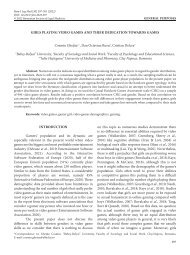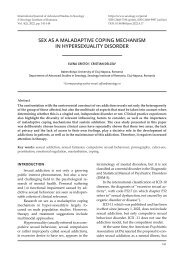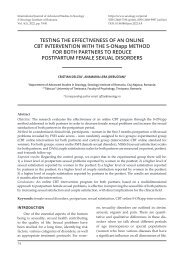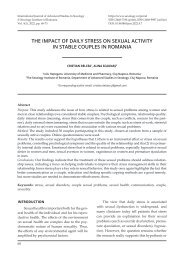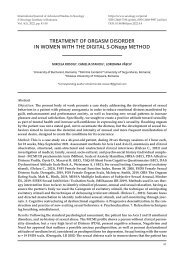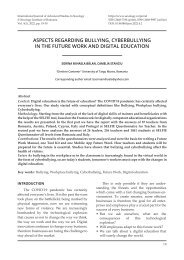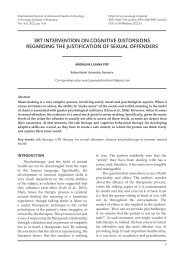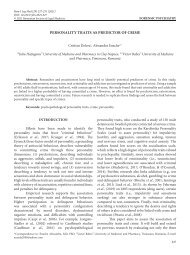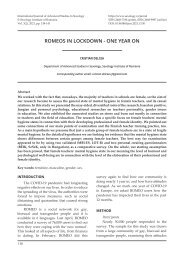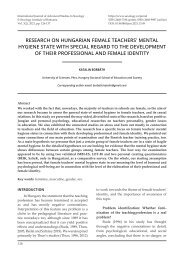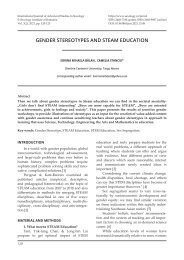A Network Analysis Approach to Romanian Resilience - Coping Mechanisms in the Covid-19 Era
The COVID-19 pandemic has posed unprecedented challenges to individuals worldwide, demanding the rapid development and utilization of coping mechanisms to navigate the recurring waves of uncertainty and disruption. Coping mechanisms are mediated by personality traits, cognitive schemes and developed perceptions. They are activated in states of stress, danger or events such as the COVID-19 period. Our study employing a network analysis approach sheds light on the coping mechanisms utilized during the recurring periods of the COVID era among a convenience sampling of 403 respondents in Romania. The findings highlight that substance use emerges as the most destabilizing factor within the pandemic resilience network, while the use of instrumental support exhibits the highest expected influence, offering valuable insights into the adaptive and maladaptive strategies that shape the Romanian population's resilience during these challenging times.They highlight the complex interplay of coping strategies and the need for tailored interventions that consider the influential positions and susceptibilities of specific coping mechanisms within the context of recurring COVID-19 waves.
The COVID-19 pandemic has posed unprecedented challenges to individuals worldwide, demanding the rapid development and utilization of coping mechanisms to navigate the recurring waves of uncertainty and disruption. Coping mechanisms are mediated by personality traits, cognitive schemes and developed perceptions. They are activated in states of stress, danger or events such as the COVID-19 period. Our study employing a network analysis approach sheds light on the coping mechanisms utilized during the recurring periods of the COVID era among a convenience sampling of 403 respondents in Romania. The findings highlight that substance use emerges as the most destabilizing factor within the pandemic resilience network, while the use of instrumental support exhibits the highest expected influence, offering valuable insights into the adaptive and maladaptive strategies that shape the Romanian population's resilience during these challenging times.They highlight the complex interplay of coping strategies and the need for tailored interventions that consider the influential positions and susceptibilities of specific coping mechanisms within the context of recurring COVID-19 waves.
Create successful ePaper yourself
Turn your PDF publications into a flip-book with our unique Google optimized e-Paper software.
Delcea et al., 2023<br />
Pharmacophore, 14(4) 2023, Pages 57-63<br />
Figure 1. Correlations heatmap between cop<strong>in</strong>g mechanisms<br />
Pearson's correlations were employed <strong>to</strong> exam<strong>in</strong>e <strong>the</strong> associations between various cop<strong>in</strong>g mechanisms. Active cop<strong>in</strong>g<br />
exhibited a robust positive correlation with plann<strong>in</strong>g (r = 0.492) and use of <strong>in</strong>strumental support (r = 0.348). Positive refram<strong>in</strong>g<br />
also showed strong positive correlations with plann<strong>in</strong>g (r = 0.358) and active cop<strong>in</strong>g (r = 0.380). Vent<strong>in</strong>g displayed a strong<br />
positive correlation with <strong>the</strong> use of <strong>in</strong>strumental support (r = 0.355) and active cop<strong>in</strong>g (r = 0.252). Fur<strong>the</strong>rmore, <strong>the</strong> use of<br />
emotional support displayed a strong positive correlation with <strong>the</strong> use of <strong>in</strong>strumental support (r = 0.617). Self-distraction<br />
demonstrated moderate positive correlations with active cop<strong>in</strong>g (r = 0.463) and positive refram<strong>in</strong>g (r = 0.427). The use of<br />
emotional support exhibited moderate positive correlations with plann<strong>in</strong>g (r = 0.382) and positive refram<strong>in</strong>g (r = 0.311).<br />
Acceptance was negatively correlated with denial (r = -0.114) and substance use (r = -0.071). Several cop<strong>in</strong>g mechanisms,<br />
such as substance use, humor, and religion, displayed weak correlations with many o<strong>the</strong>r cop<strong>in</strong>g mechanisms.<br />
Correlation analysis and network analysis are two powerful techniques used <strong>in</strong> <strong>the</strong> field of data analysis, particularly <strong>in</strong><br />
psychology, social sciences, and various o<strong>the</strong>r doma<strong>in</strong>s [14]. They are <strong>in</strong>terconnected and often complement each o<strong>the</strong>r,<br />
mak<strong>in</strong>g <strong>the</strong>ir comb<strong>in</strong>ed use essential for ga<strong>in</strong><strong>in</strong>g a comprehensive understand<strong>in</strong>g of complex systems. Correlation analysis is<br />
primarily focused on measur<strong>in</strong>g <strong>the</strong> strength and direction of relationships between variables. It helps identify which variables<br />
are associated with each o<strong>the</strong>r and <strong>the</strong> nature of those associations (positive, negative, or none) [14]. However, correlation<br />
analysis provides a limited view of <strong>the</strong> overall structure of relationships with<strong>in</strong> a dataset. <strong>Network</strong> analysis, on <strong>the</strong> o<strong>the</strong>r hand,<br />
takes correlation analysis <strong>to</strong> <strong>the</strong> next level by visualiz<strong>in</strong>g and quantify<strong>in</strong>g <strong>the</strong> <strong>in</strong>tricate network of connections among variables.<br />
Instead of exam<strong>in</strong><strong>in</strong>g pairwise correlations <strong>in</strong> isolation, network analysis constructs a network or graph where each variable is<br />
a node, and <strong>the</strong> edges represent <strong>the</strong> relationships between <strong>the</strong>m [14]. This approach uncovers <strong>the</strong> complex structures and<br />
dependencies that might be overlooked <strong>in</strong> traditional correlation matrices. <strong>Network</strong> analysis also helps identify central nodes<br />
(variables) <strong>in</strong> <strong>the</strong> network that play crucial roles <strong>in</strong> <strong>in</strong>fluenc<strong>in</strong>g o<strong>the</strong>r nodes. These central nodes are often referred <strong>to</strong> as "hubs"<br />
and are essential for understand<strong>in</strong>g <strong>the</strong> flow of <strong>in</strong>formation, <strong>in</strong>fluence, or <strong>in</strong>teractions with<strong>in</strong> a system [15]. Correlation analysis<br />
alone cannot provide this level of <strong>in</strong>sight <strong>in</strong><strong>to</strong> centrality. In situations where <strong>the</strong>re are numerous variables <strong>to</strong> consider<br />
60




